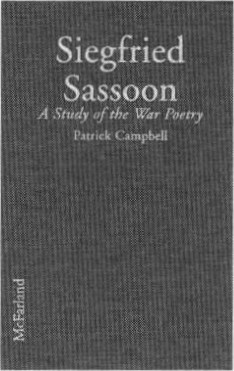|
Search Help |
|
Links Robert Graves Website Other RG Resources |

Reviews
Siegfried Sassoon: A Study of the War Poetry, by Patrick Campbell
 Siegfried Sassoon: A Study of the War Poetry, by Patrick Campbell.
Siegfried Sassoon: A Study of the War Poetry, by Patrick Campbell.
Jefferson, North Carolina: McFarland, 1999. $35.00. ISBN: 0 78640 525 2. pp. 237.
Steven Trout, Fort Hayes State University, USA
In Siegfried Sassoon: A Study of the War Poetry, Patrick Campbell revaluates one of the most influential oeuvres in twentieth-century war literature. And, as if this accomplishment were not enough, he manages to present his numerous insights and plausible re-readings within an easily accessible format that will serve the needs of both specialized scholars and classroom teachers. Seldom does one encounter a work of criticism so skilfully written with both audiences in mind.
Divided, more or less evenly, into two parts, the book is designed for ease of reference. Part I consists of seven chapters, each with the flavour of an autonomous essay, which consider such issues as Sassoon's sexuality, the true nature of his wartime protest, his 'working methods and formal concerns', his friendship with Graves and other contemporary poets, and the dimensions of his poetic achievement. Part Il offers detailed and consistently incisive explications of individual war poems, in chronological order.
Campbell's approach is refreshingly readable and entirely unpretentious. It should not, however, be confused with a lack of sophistication or intellectual daring. On the contrary, he comes close to asserting that Sassoon was Wilfred Owen's artistic equal (if not his superior), and he allows few long-standing judgments about the strengths and weaknesses of Sassoon's poetry to escape careful scrutiny and, when appropriate, informed rebuttal. In particular, he questions whether satire, Sassoon's weapon of choice in much of his wartime verse, is necessarily inferior to other modes of literary expression (an assumption which underlies most of the critical commentary that Sassoon has attracted to date), and whether Owen, upon whose artistic development Sassoon had an immeasurable impact, truly displayed more compassion in his work than his mentor did (an issue that I have long waited for a Sassoon critic to raise). Throughout this volume, Campbell demonstrates that the sheer ferocity of Sassoon's anger-driven verse has long blinded his readers to its technical complexity; behind the sledge-hammer irony is a poet no less accomplished in the fine points of poetic expression than Blunden, Owen, or Graves.
Yet while Sassoon has found in Campbell an exceptionally sympathetic and informed reader, there are no signs of hero worship in this volume or of revision for revision's sake. Sassoon's misogyny, so disturbingly apparent in poems such as 'Glory of Women', surfaces repeatedly in Campbell's analysis. So too does the disquieting duality of the poet, his vacillation between the seemingly irreconcilable personae of happy warrior and quasi-pacifist. Campbell does little to secure Sassoon's position within the pantheon of World War I literary heroes (although I found the chapter detailing Sassoon's anguished journey to 'A Soldier's Declaration' especially moving and vivid), and his study hardly inspires one to admire Sassoon's often self-absorbed personality and wildly contradictory allegiances. Rather, Campbell focuses on Sassoon as a complex and troubled poet, a wordsmith of surprising range and sophistication whose best work transcends its creator's inner conflicts and personal limitations in 'unmasking the ugly face of Mars'.
Indeed, what distinguishes this study from other assessments of Sassoon is the author's willingness to treat Sassoon's wartime verse with the kind of exhaustive attention to nuance and detail afforded great poetry. As a result, even the most seemingly straightforward examples of Sassoon's dichotomizing satire emerge illuminated by fresh insights. For example, in his analysis of 'Blighters', one of Sassoon's most deceptively simple attacks on home-front complacency, Campbell suggests that the word 'House' signifies both the music hall where drunken crowds mock the dead, and 'the chamber where politicians spout just as obscenely about the glamorous heroics of the conflict'. The Hippodrome, into which the speaker projects vengeful tanks lurching to ragtime, becomes 'a microcosm ] of a blighted nation'. Equally impressive, in terms of close reading, is the analysis of "'They'", a poem that one would hardly expect to receive seven paragraphs of intricate and convincing analysis. Consider, for instance, Campbell's trenchant discussion of the title:
The poem's title is very Sassoonesque; the pronoun 'they' conveys the sense of division between the twin perspectives of home and away. Initially the bishop employs the word four times to accord the boys, unconsciously, the status of mere ciphers. But the focus shifts to the soldiers' reply. For them the clerics are on the other side of the divide; 'they' belong to a milieu from which soldier and soldier-poet alike feel remote and which in turn marginalizes them.
Part Il of this study will doubtless serve a number of functions. One can easily imagine instructors of English literature survey courses turning to this section for further information on commonly anthologized poems. Hopefully, students will do the same. Yet I would encourage anyone with a serious interest in the literature of the Great War to re-read all of Sassoon's war poems, in chronological order, while consulting Campbell's explications (the technique that I followed in preparation for this review). What emerges is the richest account to date of Sassoon's artistic journey during the war years and his abandonment of Georgian lushness and expansiveness in favour of a tersely satirical style, his creation of a remarkably broad range of wartime voices (including those of 'mothers and bishops, amputees and dead men, parade-ground martinets and quarter-masters, tombstone makers and music hall audiences'), and his movement, in 'Dear Roberto' and 'Repression of War Experience', toward a more free-flowing, less epigrammatic, rendering of war-induced neuroses.
Impeccably researched and accessibly written, Siegfried Sassoon: A Study of the War Poetry is a major addition to Sassoon scholarship.